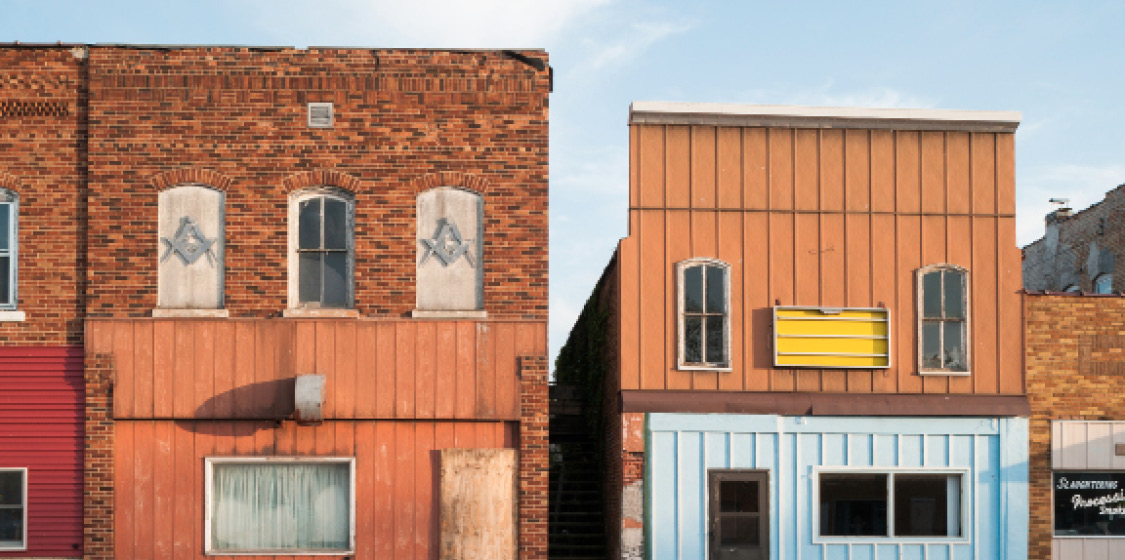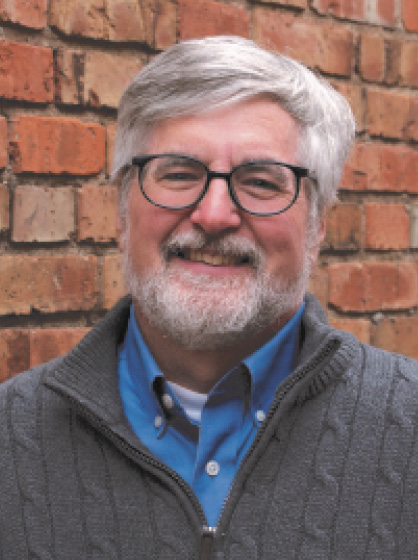The prairie has already lost many of its small farms. Now it’s losing its small towns as well. Sparsely staffed Confined Animal Feeding Operations (CAFOs) and ethanol refineries are taking their places. Dan Weeks, an occasional contributor and friend-of-the-journal, accompanies a fifth-generation rural Iowan who gives an elegiac tour.
“We used to have two grocery stores, one on each corner here,” says my host—let’s call him John—as we cross the central intersection in his town in north central Iowa. Both buildings were boarded up, their sidewalks cracked and grassy. We idle the six-block length of Main Street in his mud-spattered pickup. He points out more former storefronts: barber shop, hardware store, feed store, newspaper, law office. All empty.
We pass a big Lutheran church. “Barely enough of us left to pay the utilities,” John says. “And we need a new roof. Not going to happen.”
The high school gets the longest obituary. “Graduated here in ‘64. Won state. We consolidated four years ago.” The building—massive, brick, built in the nineteen-teens, with additions after the Second World War and again in the sixties—is abandoned. John crosses the parking lot’s faded stripes, weaves around vintage playground equipment. We end up on the cinder track that circles the former football field. The bleachers have been dismantled; the announcing box is absent, now a shed on someone’s farm. We round the track at three miles per hour. The headlights sweep the sagging backstop of a baseless ball field like a searchlight.
Field of Dreams this isn’t.
Generations ago, John’s family immigrated from Germany. They homesteaded when “the county was so wet you could canoe it from one end to the other.” His great-great grandfather tiled his fields with a spade and a strong back. When John took over the farm in the nineteen-seventies it was a huge operation. Hulks of nearly fifty-year-old equipment—a Deere combine, a big Steiger all-wheel drive articulated tractor, towering Harvestore silos—attest to that. The farm crisis finished him. He was lucky to get on as a rural mail contractor for the United States Postal Service. Driving his own pickup, he makes 515 stops a day, six days a week.
The Postal Service pays well enough to afford a remodel of the kitchen and to indulge his wife’s elaborate, country-themed landscaping schemes. Opening the house as a B & B helped. The couple lives in considerable material comfort: granite countertops, the latest appliances, new flooring. But everything else they had was gone. Land. Livestock. Independence. Calling. Community.
John seems taciturn, uncomplaining, pragmatic. My wife, Randi, and I, staying at their Bed & Breakfast, hadn’t asked for the tour of what was left of the town. Conducted at a dirge’s pace, it proved steeped in almost unbearable loss, all related in a slow, flat monolog: The neighbors had not only lost their farms, but their houses too—now bulldozed into more corn and bean ground and owned by the few big grain operations that had survived.
John’s son will inherit John’s farmhouse and barnyard, but not a farm. The son works for an international meat processing company, feeding thousands of confined hogs on John’s property in a massive shed with attached feed bins. Such arrangements are called CAFOs—Confined Animal Feeding Operations. The son is paid an hourly wage. No benefits, no equity, no profit share.
“I told him he could use this site for the confinement shed,” John says. “He needed a job and he didn’t want to leave. But I wasn’t going to work with him for that outfit. That ain’t farming.” He says it matter-of-factly but spit out the final three words with the banked rage of a serf who’d once been a lord.
The terms of his son’s contract prohibited John from showing us inside the shed. (“Too many animal activists,” he said.) There, he told us, hogs lay on a steel grid over a lagoon of their own manure. The lagoon is emptied once a year.
John speaks with a mixture of pride and resentment about the only new business in town, and perhaps the largest in the county: the corn ethanol plant. From his front yard, its bright lights, steaming stacks, and oil-refinery-like array of tanks and pipes were just barely visible, a bright glow on the dusky horizon. It covered as much ground as a good-sized, 1970s Iowa farm and towered higher than a grain elevator. “It kind of puts us on the map again,” he says.
The ethanol plant was enabled by subsidies and tax breaks introduced into national policy as the Renewable Fuels Standard (RFS) in 2005. Big agricultural lobbies seeking more markets for the country’s largest grain commodity had a lot to do with RFS’s enactment. The ethanol is blended with gasoline and sold at subsidized, below-market rates. The result is slightly cheaper auto fuel, but at the cost of billions of taxpayer dollars in tax revenue and more expensive groceries, as food producers now have to compete with ethanol plants for corn.
The plant “ate corn and pissed alcohol,” says John. The ethanol company had promised to bring high-paying local jobs to the area. But the refinery was built mostly by national and international construction firms specializing in such plants. These firms employ crews of highly skilled, highly paid workers who travel the continent building ethanol refineries. Many of the workers camped on the abandoned football field in 5th-wheel RVs nearly as big as semitrailers. They left when the plant was complete. We saw the ruts their rigs had made in the turf. Circumnavigating the field, John’s resentment of these transients squatting on his school’s patch of glory with their big fancy rigs was palpable.
“Now,” he says of the plant, “they can man the whole outfit with three, four guys a shift. They’re not from here either, most of ’em.”
The refinery promised a market for corn stover—the corn shucks, leaves, and stalks that remain after harvesting—as well as the grain itself. That would have turned field waste into a paying crop for local farmers. “But they wanted everything harvested just so. You had to have a so-many-row combine head, a special type of baler,” John says. “You had to bale it to spec, transport it and deliver it to schedule. A fella would buy the equipment—huge investment—and then they’d change the rules. Not worth it. Some guys lost their shirts.”

Photo by David Ottenstein
Compared to them, John considers himself lucky. But the occupation and community his family had helped to create in Iowa for generations was gone, along with any semblance of a sustainable local economy.
A Wisconsin dairy farmer—quoted in “The Last Stand,” an article in the August 17, 2020 issue of The New Yorker—sums up the situation: “It’s not the farming that I was brought up with,” says Jerry Volence. “It’s not really even farming anymore. It’s mining. We’re extracting resources and shipping them away, and they’re not coming back. There’s no cyclical nature to it. It’s a straight line out.”
At the end of our tour, we returned to John’s house and sat with him and his wife on his porch as the sun set. We tried to think of an appreciative and encouraging response to what we’d just seen and heard, but there was an awkward silence while I pondered what that might be. Eventually I just thanked him for showing us around. Randi added that the town and his farm clearly had a proud history. That was the best we could do, and it didn’t feel good enough.
John just nodded, and looked down the highway leading south, past the ethanol plant and its rail rail siding. There a long line of tank cars waited to haul the ethanol to St. Louis, perhaps, or Chicago, where it would help fuel the urban commute. None of it will end up in John’s mail truck. It runs on diesel.


